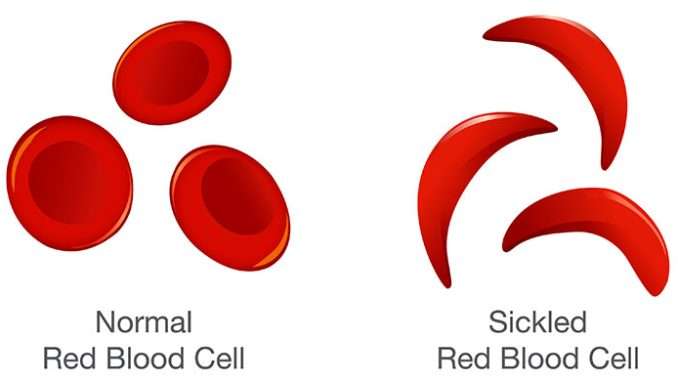
Sickle cell anemia is a blood disorder that a child is born with. Its other name is sickle cell disease. This disorder affects the shape of the red blood cells. Red blood cells carry oxygen to all parts of the body. Red blood cells are usually round in shape. Therefore, they easily move through the blood vessels. Therefore, the red blood cells in sickle cell anemia are in the shape of sickles. The cells are also so rigid. This may slow or stops the blood flow. Hence, the organs of the body and tissues fail to get enough oxygen.
Symptoms.
- Extreme pain in the joints.
- Frequent infections.
- Swelling of the hands and feet.
- Anemia.
- Pain in the chest.
- Delayed development.
- Vision problems.
- Sausage joints.
- Dizziness due to low oxygen.
- Tiredness or fatigue.
Causes.
In red blood cells, there is a blood protein called hemoglobin. It carries oxygen in the blood. In addition, hemoglobin gives blood its red color. However, the hemoglobin in the sickle causes the red blood cells to be sticky. In the case where both parents carry sickle cell trait in them, this may be passed to their child. So, incase one of the parent passes the sickle cell gene to the child, the child may carry the sickle cell trait. There after they are said to be the carriers of the disease.
Complications from Sickle Cell Anemia.
- Stroke.
- Hypertension.
- Organ damage.
- Blindness.
- Leg ulcers.
- Gallstones.
- The sickle cell may lead to pregnancy complications.
Diagnosis.
Medical personnel takes a sample to check the form of the sick cell hemoglobin in the blood. They also draw blood from the veins in the arm and it is taken to the laboratory.
Treatment.
The doctors try to manage sickle cell so as to reduce the pain levels, and symptoms and prevent complications. Treatment includes both medication and blood transfusion. However, children may undergo a stem cell transplant to cure the illness.
- Over the counter pain relieving medicines.
- Oxygen offered as a supplement through a mask.
- Immunizations may help to avoid infections due to the low immune level.
- Hydroxyurea which may help in production of hemoglobin.
Surgical procedures include blood transfusion and stem cell transplant.
Home Remedies.
There are practices that one may carry out help them avoid complications of sickle cell anemia, these are;
- Take about8-12 glasses of water daily.
- Avoid stress as much as possible.
- Don’t take too much alcohol.
- Carry out exercise frequently .
- Don’t smoke.
- Avoid places with extreme temperatures.
- Take folic acid supplements.
- Dalvin Cook age, height, spouse, children, football, net worth.
- Jackson Dill WSVN -7 news, age, children, wife, net worth.
- Jane Fonda bio-Age, Edu, Relationship, Career, awards, net worth
- Dave Fraser Bio-Age, Family, Children, Wife, Net Worth, Career.
- Lou Retton age, family, children, husband, career, net worth.
- Susana Harbert Bio, Wiki, KTAB News, Age, Education, Family, Children, Husband, Net Worth, and Career
- Janessa Webb Bio, Age, Children, Husband, and Net Worth
- The best private primary schools in Nyeri county.
- What is the history of Kenyatta University?
- Public Universities in Kenya
- Kenya Medical Training College, courses, requirements.
- Egerton university, fees, location, courses.
- Best Public High Schools in Kiambu County.
- How is The Lenana Boy school and location?